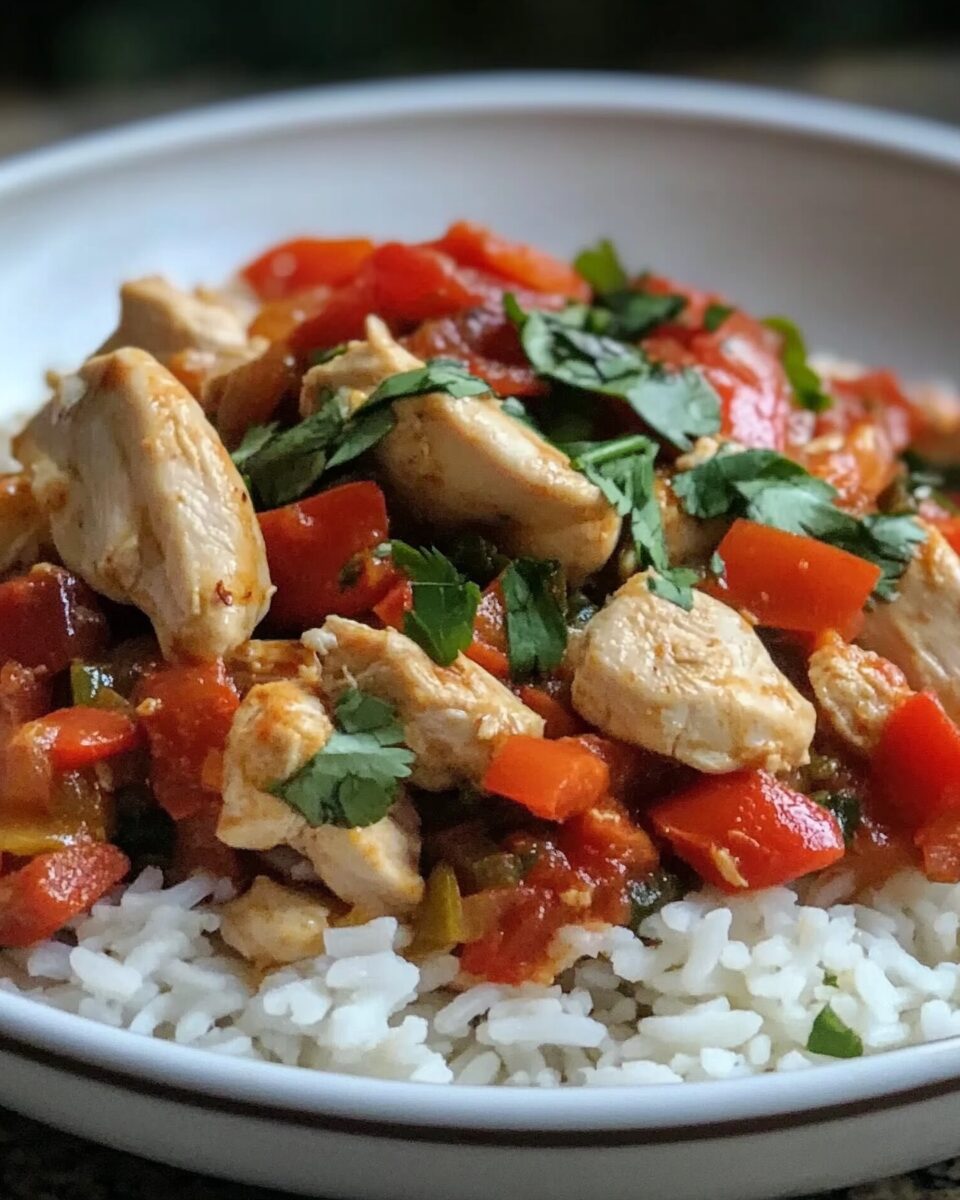Kadai Chicken, also known as Chicken Karahi, is a popular North Indian and Pakistani dish renowned for its rich and spicy flavors. Cooked in a traditional wok-like vessel called a ‘kadai’ or ‘karahi,’ this curry features tender chicken pieces simmered in a fragrant tomato-based gravy, complemented by freshly ground spices and bell peppers. It’s a delightful main course that pairs well with naan, roti, or steamed rice.
Full Recipe:
Ingredients:
- 1 kg chicken, cut into pieces
- 2 tablespoons oil or ghee
- 1 teaspoon cumin seeds
- 2 large onions, finely chopped
- 1 tablespoon ginger-garlic paste
- 3 large tomatoes, pureed
- 2 green bell peppers, cut into cubes
- 2 teaspoons coriander powder
- 1 teaspoon turmeric powder
- 1 teaspoon red chili powder
- 1 teaspoon garam masala
- Salt to taste
- Fresh cilantro leaves, chopped (for garnish)
Directions:
- Heat oil in a kadai: Add cumin seeds and let them splutter.
- Sauté onions: Add finely chopped onions and cook until golden brown.
- Add ginger-garlic paste: Cook for a minute until the raw aroma disappears.
- Incorporate spices: Stir in coriander powder, turmeric powder, and red chili powder. Cook for another minute.
- Add chicken pieces: Cook until they are lightly browned on all sides.
- Pour in tomato puree: Mix well, cover, and let it simmer until the chicken is tender and cooked through.
- Add bell peppers: Cook for an additional 5 minutes until they are slightly tender yet crisp.
- Finish with garam masala: Stir well and adjust salt to taste.
- Garnish and serve: Top with fresh cilantro leaves and serve hot with your choice of bread or rice.
Nutritional Facts:
Per serving (approximate values):
- Calories: 320
- Total Fat: 20g
- Saturated Fat: 5g
- Cholesterol: 80mg
- Sodium: 450mg
- Total Carbohydrate: 10g
- Dietary Fiber: 2g
- Sugars: 4g
- Protein: 25g
The Origins of Kadai Chicken
The name “Kadai Chicken” comes from the vessel in which it is traditionally cooked—the kadai (or karahi). A kadai is a deep, round, and thick-bottomed wok-like pan commonly used in Indian and Pakistani cooking. This cooking method enhances the flavors by allowing the spices to blend beautifully with the chicken and vegetables.
Kadai Chicken has its roots in Mughlai cuisine but has since evolved into a popular dish across India and Pakistan. Over time, regional variations have emerged, each with its own unique twist on the spice blend and cooking technique. Some versions include yogurt for a slightly creamy texture, while others stick to a dry, stir-fried style. No matter the variation, Kadai Chicken remains a crowd-pleaser.
Why Kadai Chicken is a Popular Choice
Kadai Chicken is a favorite dish for many reasons:
- Rich and Aromatic Flavor – The dish features a robust combination of freshly ground spices, giving it a deep and complex flavor profile.
- Quick and Easy to Prepare – Unlike slow-cooked curries, Kadai Chicken can be made in under an hour, making it a great option for weeknight meals.
- Perfect for Special Occasions – The vibrant red color and rich aroma make it an ideal dish for festive gatherings and family dinners.
- Pairs Well with Various Sides – Whether served with naan, paratha, roti, or steamed rice, Kadai Chicken complements a wide range of Indian bread and grains.
The Key Spices That Make Kadai Chicken Special
One of the defining features of Kadai Chicken is its unique spice blend, which gives the dish its signature taste and aroma. Unlike many other curries that use pre-ground spices, Kadai Chicken often includes freshly ground whole spices. Here are some of the essential spices used in this dish:
- Coriander Seeds – Adds a citrusy, slightly sweet flavor that enhances the taste of the dish.
- Cumin Seeds – Imparts a warm, earthy aroma that complements the chicken.
- Dried Red Chilies – Provides heat and deepens the color of the gravy.
- Garam Masala – A blend of warming spices such as cloves, cinnamon, and cardamom, adding depth to the dish.
- Turmeric – Gives the dish a beautiful golden color while adding health benefits.
- Red Chili Powder – Enhances the spice level, making the dish more flavorful and vibrant.
These spices are often dry roasted and ground together to create an aromatic and flavorful masala that forms the base of Kadai Chicken. This homemade spice mix sets it apart from other Indian chicken dishes.
The Importance of Fresh Ingredients in Kadai Chicken
Another reason Kadai Chicken is so flavorful is the use of fresh ingredients. Unlike many dishes that rely on heavy cream or coconut milk, Kadai Chicken uses a tomato-based gravy, which brings natural sweetness and acidity to balance the heat of the spices.
Bell peppers (capsicum) are another key ingredient that enhances the taste and texture of the dish. They provide a slightly crunchy texture and a subtle sweetness that balances the spice. Green bell peppers are most commonly used, but red and yellow bell peppers can also be included for a more colorful and slightly sweeter version.
Fresh ginger and garlic are also essential components of Kadai Chicken. The combination of ginger and garlic paste gives the dish a bold, savory foundation that pairs perfectly with the tangy tomatoes and fragrant spices.
Different Variations of Kadai Chicken
While the traditional version of Kadai Chicken remains the most popular, there are several variations of this dish based on regional preferences and dietary choices:
- Kadai Chicken with Yogurt – Some recipes include a small amount of yogurt to add a slight creaminess to the dish without overpowering the spices.
- Dry Kadai Chicken – This version has little to no gravy, making it more like a stir-fry. It is often served as a side dish with dal and rice.
- Kadai Chicken with Cream – Some restaurant-style versions use a small amount of cream or butter to give the dish a rich and velvety texture.
- Spicy Kadai Chicken – For those who love extra heat, additional red chili powder or fresh green chilies can be added.
- Kadai Chicken with Cashew Paste – A unique variation where cashew paste is blended into the gravy for a nutty and mildly sweet flavor.
Each variation has its own charm, and the dish can be adjusted based on personal preferences and spice tolerance.
Serving Suggestions for Kadai Chicken
Kadai Chicken is a versatile dish that pairs well with different types of bread and rice dishes. Here are some serving suggestions:
- Naan or Roti – The soft texture of naan or whole wheat roti complements the spicy and flavorful gravy.
- Jeera Rice – Flavored with cumin seeds, jeera rice enhances the taste of Kadai Chicken without overpowering it.
- Plain Steamed Rice – A simple way to enjoy Kadai Chicken while letting the flavors shine.
- Lachha Paratha – The crispy, flaky layers of paratha add a delightful texture to the meal.
- Cucumber Raita – A side of cool, refreshing raita balances the heat of the dish.
Health Benefits of Kadai Chicken
While Kadai Chicken is known for its bold flavors, it also offers several health benefits:
- High in Protein – Chicken is an excellent source of lean protein, which helps build and repair muscles.
- Rich in Antioxidants – The use of fresh tomatoes and bell peppers provides a good dose of antioxidants that support overall health.
- Boosts Metabolism – Spices like cumin, turmeric, and red chili powder are known to aid digestion and boost metabolism.
- Low in Carbohydrates – Since the dish does not use heavy cream or starchy ingredients, it is a great option for those following a low-carb diet.
Storage and Reheating Tips
If you have leftovers or want to prepare Kadai Chicken in advance, here are some storage and reheating tips:
- Refrigeration – Store Kadai Chicken in an airtight container in the refrigerator for up to 3 days.
- Freezing – It can be frozen for up to a month. To reheat, allow it to thaw in the refrigerator overnight before warming it up.
- Reheating – Reheat on the stovetop over low heat, adding a splash of water if needed to maintain the consistency of the gravy.
Conclusion
Kadai Chicken is a true celebration of Indian flavors, bringing together aromatic spices, fresh ingredients, and bold tastes in a single dish. It is a beloved recipe that can be customized to suit different preferences, making it a go-to meal for both special occasions and everyday dinners.






